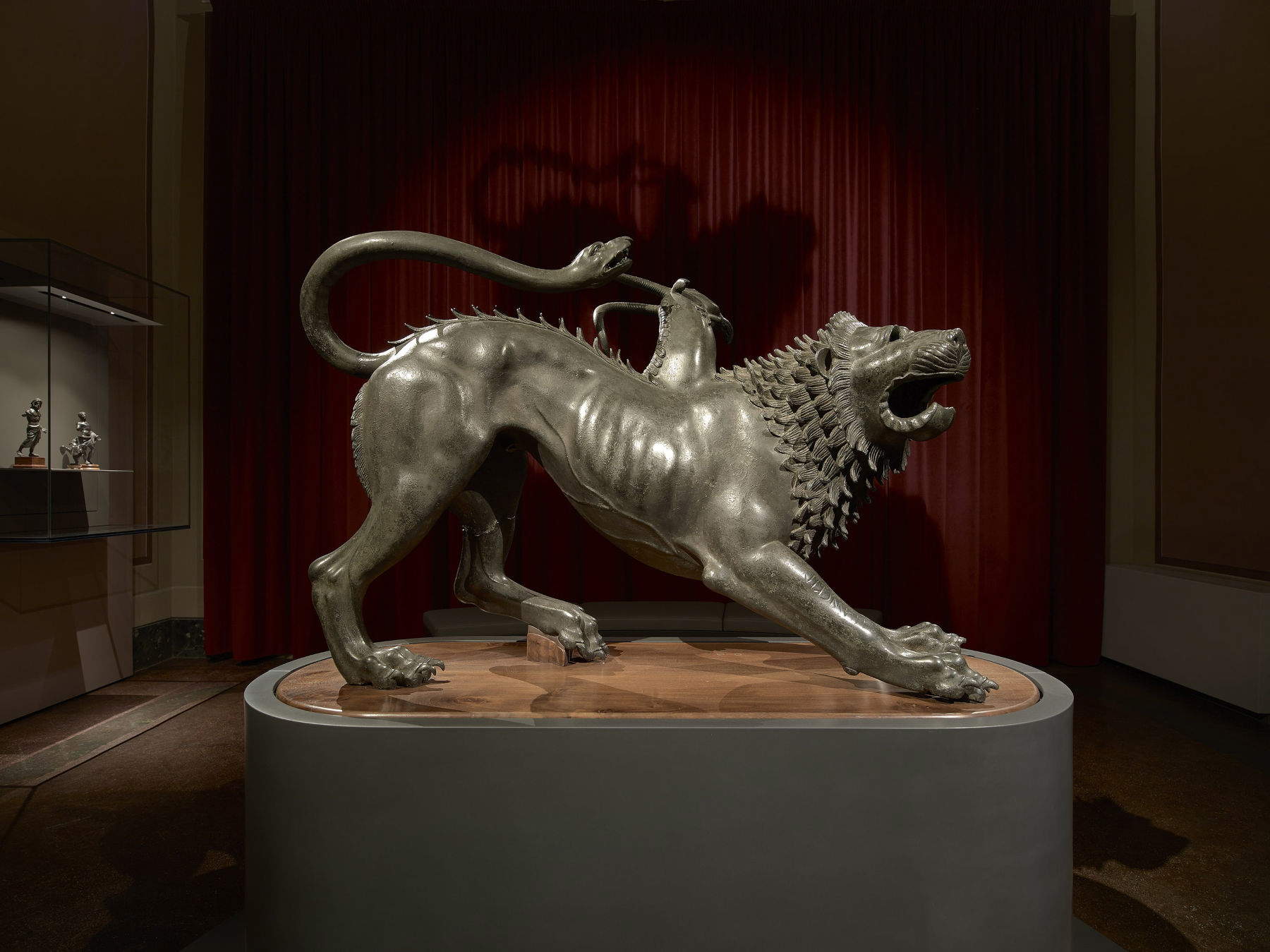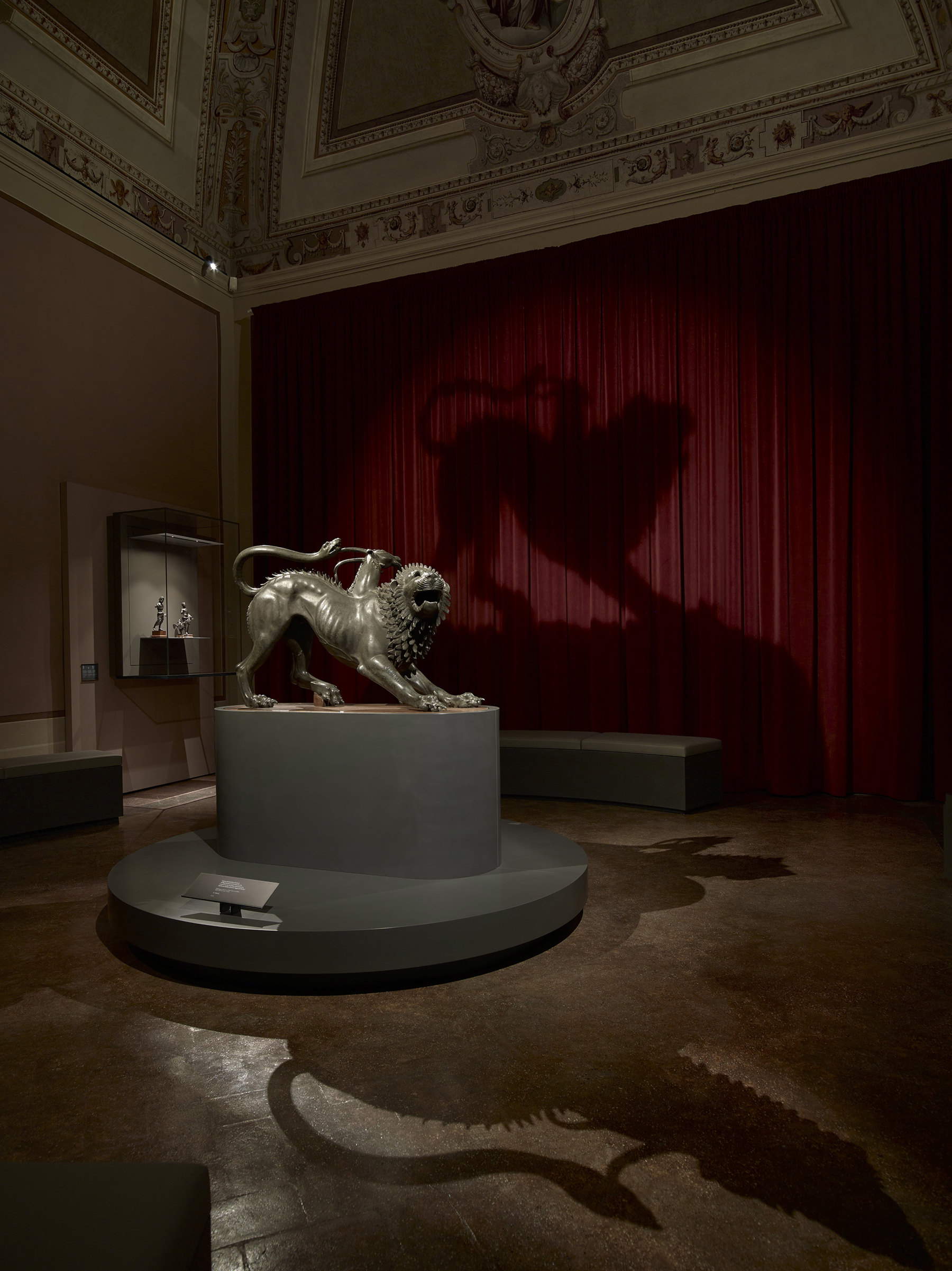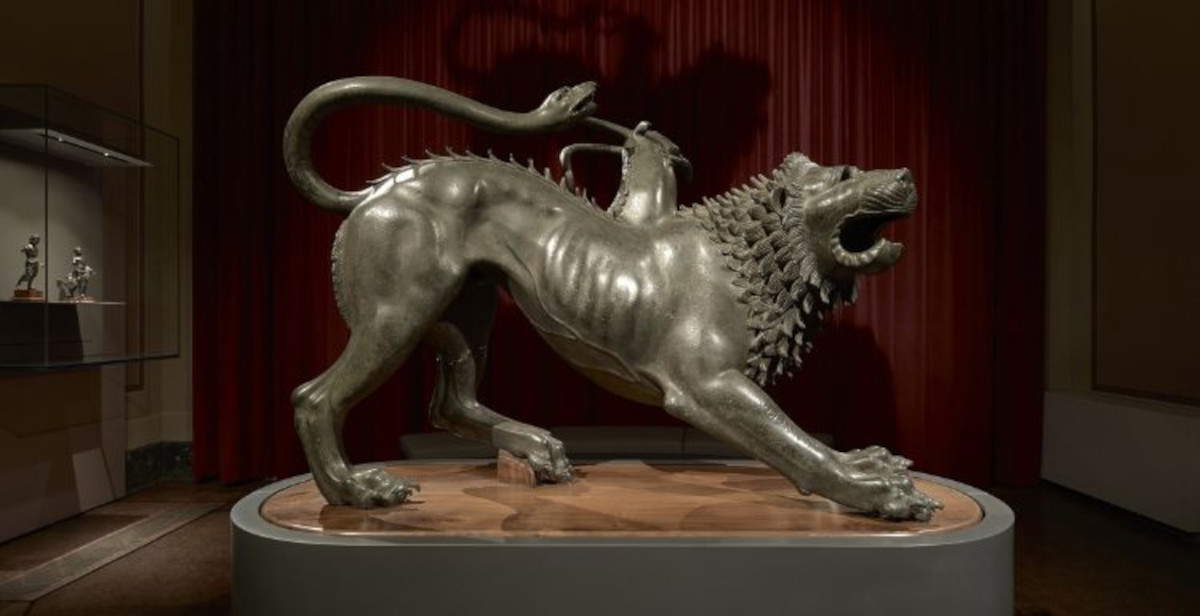The National Archaeological Museum in Florence returns the Hall of the Chimera to the public, renovated with an exhibition project that focuses on an immersive experience and a close-up view of the work considered the symbol ofEtruscan art. The sculpture(more on it here), inscribed with number 1 in the Museum’s inventory, is inextricably linked to the history of Medici collecting: it was found in Arezzo on November 15, 1553 and immediately became part of Cosimo I de’ Medici’s possessions, entering among the most representative nuclei of the Medici collection. The new installation, designed by the Florentine firm Guicciardini & Magni in collaboration with the Museum’s Technical Office and curators Barbara Arbeid and Claudia Noferi, introduces a stage layout that envelops the Chimera d’Arezzo in an almost theatrical dimension. The intervention was unveiled during the inauguration in the presence of the Director General of Museums, Massimo Osanna, the director of the National Archaeological Museum of Florence, DanieleFederico Maras, the head of the Technical Office Luca Gullì, the designer Marco Magni and the Museum’s curators.
“The Chimera,” commented Museums General Director Massimo Osanna, “is one of the most recognizable symbols of Etruscan art and our country’s cultural heritage. Giving it back a space designed to welcome it and tell its story with new languages means focusing on the quality of the museum experience, the accessibility of its contents and attention to the public. This intervention represents an important step in the path of renewal of the National Archaeological Museum of Florence, which in recent months is initiating a comprehensive review of its exhibition spaces, as part of the broader commitment of the General Directorate of Museums in the renewal of languages and forms of enjoyment of the places of culture of the National Museum System.”
“It is with great pride and satisfaction that today we present the new permanent exhibition of our Chimera,” comments Daniele Federico Maras, Director of the Museum. “An exhibition designed to offer each of us an intimate and personal experience of this extraordinary work of art, using the communicative forms of theater, monument and participation and avoiding sources of distraction. We are thus fulfilling the promise of a project already initiated by my predecessor Mario Iozzo and made possible by the generous funding of American couple Laura and Jack Winchester, friends of the city of Florence and its Archaeological Museum.”

The centerpiece of the hall is the new monumental plinth made by Goppion SpA, which emphasizes the plastic impact of the bronze statue depicting the creature described by Lucretius as “one with threefold body: at one end a lion, at the other a serpent and in the middle a goat,” and by Pseudo-Apollodorus as “a single creature with the power of three beasts.” The arrangement of the four circular benches around the sculpture creates a direct vantage point designed to foster a personal relationship with the work, protected in its delicacy and symbolic value. A distinctive element of the new installation is the large curtain that recalls a theater curtain. The shadow of the Chimera is cast on it, accentuating the meditative character of the room. The room is complemented by a suspended display case that features three small Etruscan bronzes, a griffin, the god Tinia and a young offerer, from the same archaeological context as the Chimera find. Their presence creates a direct reference to the site and history of the work.
The lighting, on the other hand, designed by Florence-based Studio Iarussi, defines a purposeful balance between light and shadow, enhancing the sculpture’s anatomical details and most expressive features. The itinerary is complemented by a newly designed illustrative apparatus, the first piece of the museum’s new graphic identity developed by studio Rovai-Weber. Also among the new features is the Educational Services mascot, Musetta, designed by Claudia Noferi and created by artist and archaeologist Silvia Bolognesi. Musetta is proposed as a dedicated guide for younger visitors, with the aim of introducing them to the richness of Florence’s archaeological heritage. The reopening of the room coincides with a significant institutional transition: the National Archaeological Museum of Florence now operates as an autonomous institute, established in 2024 and directed by Daniele Federico Maras, after the period under the Regional Directorate National Museums of Tuscany headed by Stefano Casciu. The installation of the Hall of the Chimera represents a stage in a renovation project, which will continue with the refurbishment of the rooms dedicated to Etruscan sculpture. Works such as theArringatore and Lorenzini’s Head will find a place in those new spaces, as part of an exhibition focusing on the long history of the Grand Ducal collections. Openings are scheduled to take place in the coming months.


“Today happily concludes,” says Stefano Casciu, Regional Director of National Museums Tuscany, “the project conceived and initiated by Mario Iozzo during the period of his direction of the Museum, aimed at completely renovating the museum display of the Chimera and other works related to it, and which saw the involvement and financial support of Laura and Jack Winchester. With them, the Regional Directorate National Museums Tuscany, as the institute to which the Archaeological Museum of Florence previously belonged, has also carried out other important museum rearrangements over the years. To them and to my colleague Mario Iozzo goes my heartfelt thanks, which is extended to the current director Daniele Federico Maras and all the technical and administrative staff involved, who still guarantee an intense and direct operational collaboration between the Regional Directorate and the new autonomous museum.”
The renovation program also ties in with the museum’s desire to commemorate the 1966 Florence flood, an event that hit the archaeological collections hard and whose 60th anniversary, scheduled for Nov. 4, 2026, is approaching. The National Archaeological Museum of Florence remains open for the duration of the work. Visiting hours are Monday through Saturday from 8:30 a.m. to 2 p.m., with an extension until 7 p.m. on Tuesdays and Thursdays. Special openings dedicated to the new hall are also planned: Sunday, December 7 from 8:30 a.m. to 2 p.m., and the evenings of Wednesday, November 26, and Wednesday, December 3, from 6 to 10 p.m., with special emphasis on the date of December 3, coinciding with the International Day of Persons with Disabilities.
 |
| The Hall of the Chimera at the Archaeological Museum of Florence reopens with a new display |
Warning: the translation into English of the original Italian article was created using automatic tools. We undertake to review all articles, but we do not guarantee the total absence of inaccuracies in the translation due to the program. You can find the original by clicking on the ITA button. If you find any mistake,please contact us.